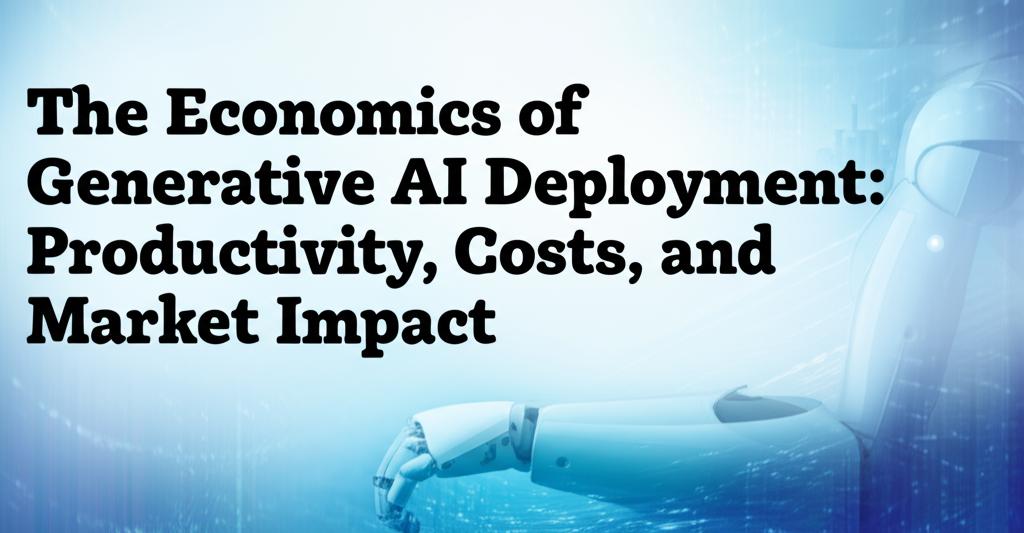Generative AI is rapidly transforming business operations, moving from experimental technology to a core driver of value. Its deployment requires careful consideration of productivity gains, associated costs, and the broader impact on the market landscape. Understanding these economic factors is crucial for organizations seeking to leverage this powerful technology effectively.
Productivity Enhancements Across FunctionsOne of the most significant economic impacts of generative AI stems from its potential to boost productivity. By automating repetitive tasks and augmenting human capabilities, it frees employees to focus on higher-value, strategic activities. Studies estimate generative AI could enable annual labor productivity growth between 0.1% and 0.6% through 2040.
Key areas seeing productivity benefits include:
- Customer Operations: AI-powered chatbots and digital self-service tools handle inquiries, improving response times and agent productivity. McKinsey estimates generative AI could increase productivity in customer care by 30% to 45% of current function costs.
- Marketing and Sales: Automation of content creation (emails, marketing copy, personalized campaigns) significantly reduces ideation and drafting time. AI can also enhance lead identification and outreach, potentially increasing sales productivity by 3% to 5% or more.
- Software Engineering: Generative AI assists with code generation, translation, and analysis, accelerating development cycles.
- Research and Development (R&D): The technology aids in analyzing vast datasets, generating insights, and speeding up the innovation process.
- Content Creation: AI can generate text, images, video, and audio, automating tasks for journalists, creatives, and designers.
Some reports suggest that current generative AI technologies could automate activities consuming 60% to 70% of employee time today, with potentially half of all work tasks being automated between 2030 and 2060. Firms integrating generative AI have reported productivity increases up to 40%.
Analyzing the Costs of DeploymentWhile the productivity gains are compelling, deploying generative AI involves significant costs that must be managed. A thorough Total Cost of Ownership (TCO) analysis is essential. Key cost components include:
- Technology Acquisition: This covers hardware (powerful servers, GPUs), software licenses, and platform subscriptions. Costs vary dramatically based on scale, potentially ranging from tens of thousands to over $750,000 for initial setup.
- Model Selection and Access: Costs differ based on using commercial APIs (usage-based pricing), deploying open-source models (requires technical expertise and infrastructure), or custom model development (highest upfront cost). Ongoing inference costs for large models can also be substantial.
- Integration: Connecting AI systems with existing IT infrastructure and workflows can incur significant expenses.
- Personnel: Hiring AI specialists or training existing staff represents a major investment. There's currently a global shortage of skilled AI professionals.
- Data Management: Preparing, structuring, and securing the data needed to train or fine-tune models is critical and costly.
- Maintenance and Operations: Ongoing costs include compute resources, API calls, system updates, and support.
- Governance and Compliance: Ensuring responsible AI use, addressing bias, maintaining security, and adhering to regulations adds to the cost burden.
Despite these costs, strategic AI adoption is viewed as an investment. Some estimates suggest that generalized adoption could reduce operational costs by 25% to 35% by 2025. Early adopters are reportedly seeing strong returns, sometimes exceeding 3 times their initial investment.
Market Impact and Economic PotentialGenerative AI is not just optimizing existing processes; it's reshaping industries and driving substantial economic value.
- Economic Growth: Estimates suggest generative AI could add $2.6 trillion to $4.4 trillion annually to the global economy across examined use cases. Some projections forecast a $7 trillion boost to global GDP over the next decade. By 2030, the cumulative global economic impact could reach nearly $20 trillion.
- Market Size: The global generative AI market is experiencing explosive growth. Valued around $20.9 billion in 2024, projections estimate it will reach between $89.9 billion (by 2029) and $136.7 billion (by 2030), with Compound Annual Growth Rates (CAGRs) exceeding 34%.
- Industry Transformation: AI is enabling new product development, personalized customer experiences, and market expansion. Sectors like finance, healthcare, entertainment, retail, and manufacturing are leveraging AI for tasks ranging from fraud detection and drug discovery to predictive maintenance and personalized recommendations.
- Investment Surge: Global private investment in generative AI reached $33.9 billion in 2024, part of an overall AI investment landscape that saw significant growth. Major tech companies are heavily investing, integrating AI into their core offerings.
- Adoption Rates: Business adoption is accelerating rapidly. Surveys indicate that around 71% to 78% of organizations now use AI (including generative AI) in at least one business function, a substantial increase from prior years.
Successfully harnessing the economics of generative AI requires a strategic approach. Businesses should align AI investments with clear objectives, whether it's improving efficiency, enhancing customer value, or creating new revenue streams. A phased deployment, continuous monitoring of costs and benefits, and investment in workforce upskilling are crucial for maximizing ROI and mitigating risks like data security and model inaccuracies. While many organizations report cost reductions and revenue gains at the functional level, achieving significant enterprise-wide bottom-line impact is still an evolving process.
Generative AI presents a profound economic opportunity, driving productivity, enabling cost savings, and reshaping markets. However, realizing this potential demands careful planning, substantial investment, and strategic management to navigate the associated costs and complexities effectively.

